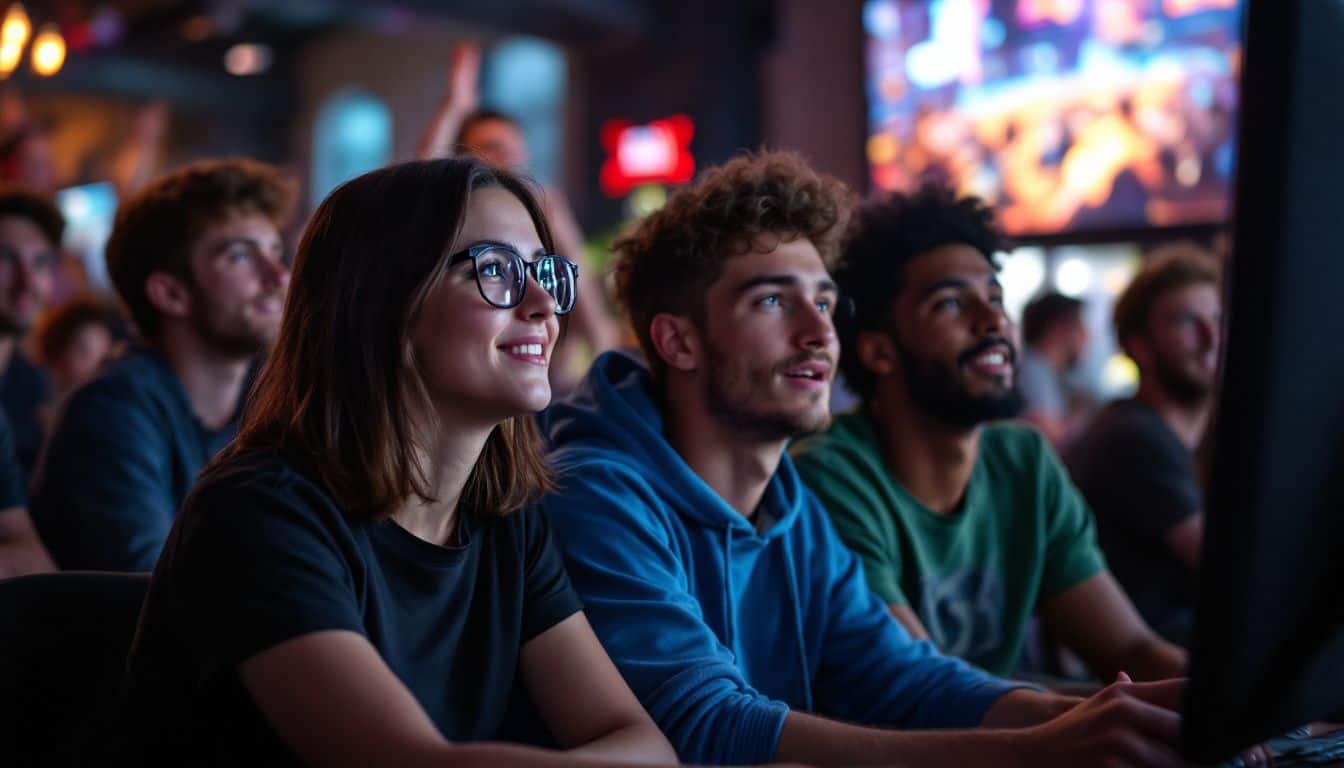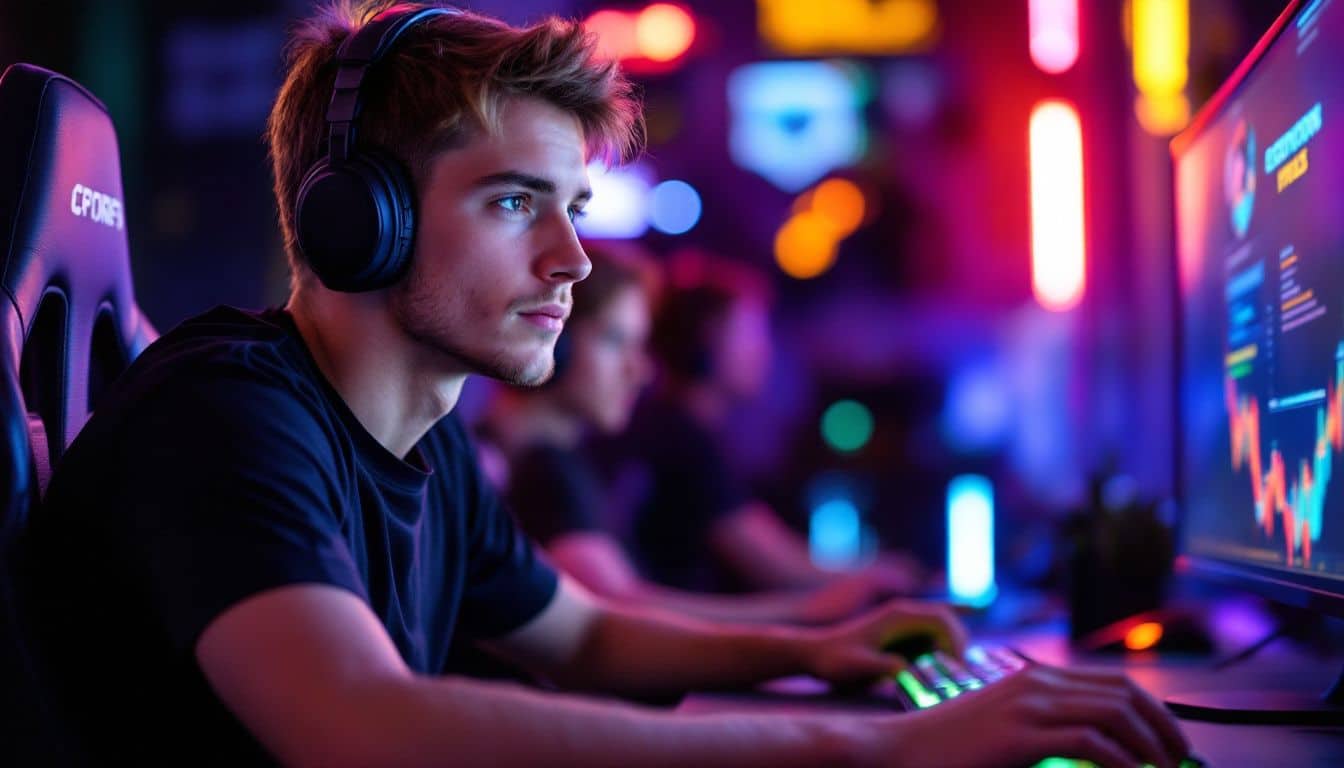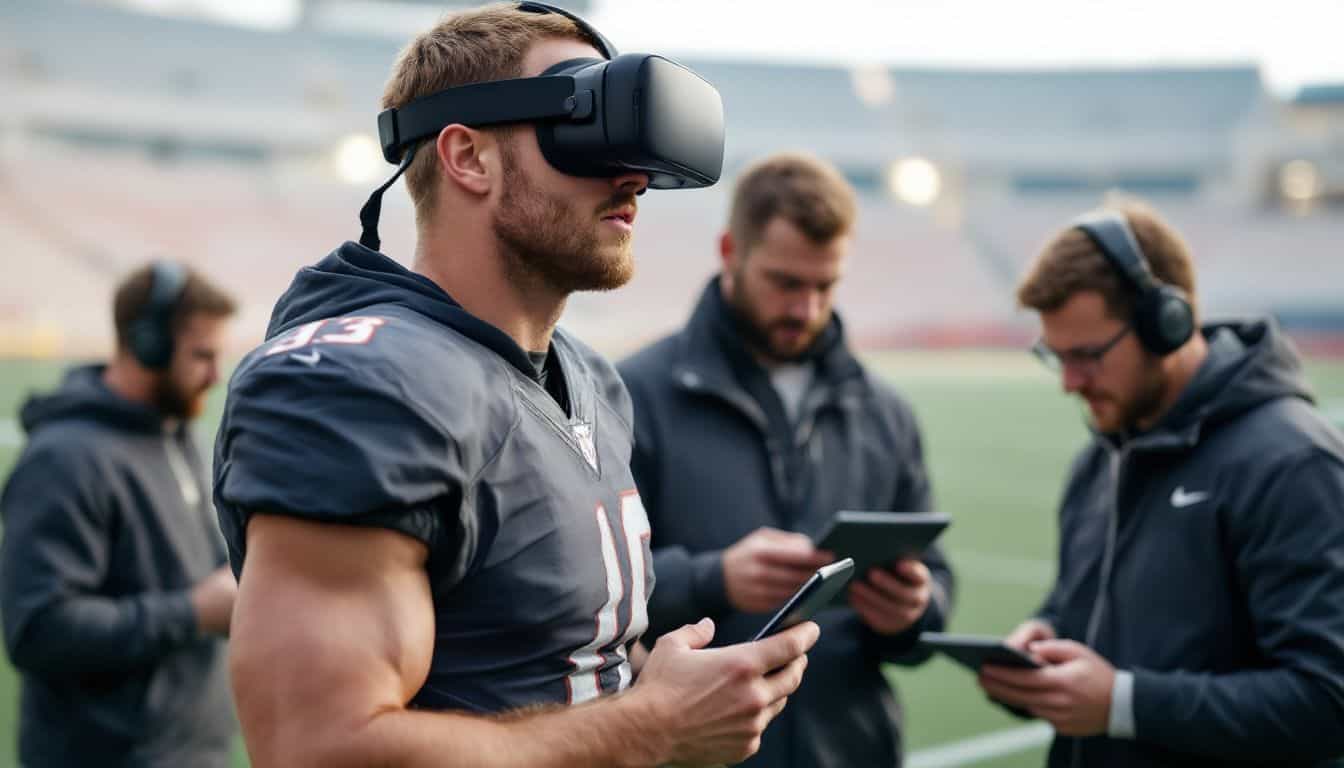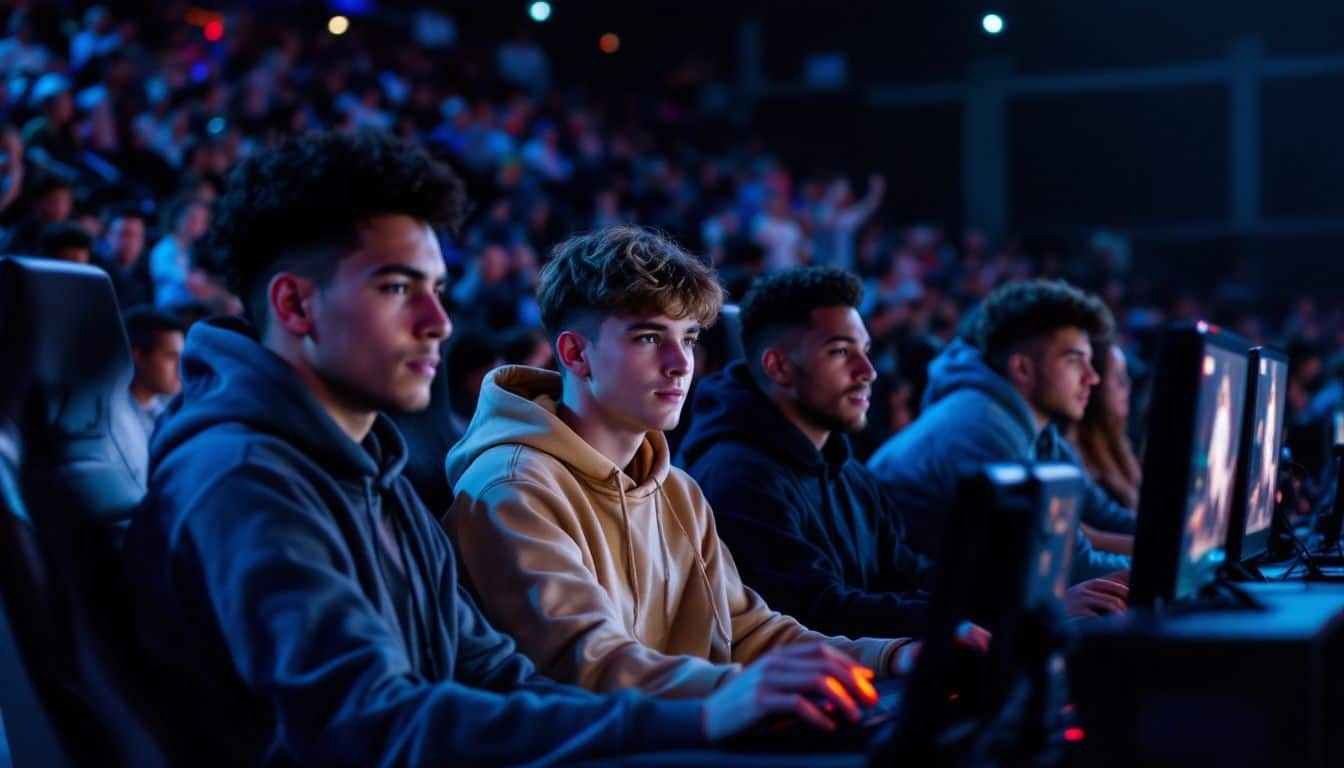The impact of esports on traditional sports has created a major shift in how people watch and play games today. Live streaming platforms like Twitch draw over 31 million daily viewers, surpassing many cable TV sports channels.
This blog post breaks down seven key trends that show how esports and traditional sports now work together to create better experiences for fans. Get ready to discover why both worlds need each other to grow.
Key Takeaways
Esports has grown massively, with League of Legends Championships drawing 100 million viewers. Global esports fans jumped from 270 million in 2016 to 495 million by 2020. The industry made $641 million from sponsorships in 2021.
Traditional sports teams now copy esports’ digital strategies. They use VR training, data analytics, and interactive fan zones. Many pro teams like Manchester City and FC Barcelona have launched their own esports divisions to reach younger fans.
Young viewers aged 18-34 make up 73% of the esports audience. This shift has forced traditional sports to change how they engage fans. Popular streamers like Tyler “Ninja” Blevins help bridge the gap between physical sports and gaming through cross-promotional events.
Esports viewership now beats some traditional sports in the U.S. In 2021, esports had 84 million viewers, compared to MLB’s 79 million and NBA’s 63 million. Live streaming platform Twitch draws over 31 million daily viewers.
Both sports types share core elements, but differ in physical demands. Traditional sports require bodily stamina, while esports focus on mental skills and quick thinking. Both fields need teamwork, strategy, and endless practice to succeed.
Table of Contents
Growth of Esports

Esports has exploded from small arcade tournaments to filling Madison Square Garden with screaming fans. Global viewership numbers now rival traditional sports, with League of Legends World Championship drawing over 100 million viewers in a single event.
Increasing global viewership

Global viewership numbers for competitive gaming have skyrocketed in recent years. The League of Legends World Championship grabbed over 5 million viewers at once in 2022, matching many major sports events.
Live-streaming platform Twitch doubled its viewership from 600,000 to 1.2 million concurrent viewers between 2015 and 2018. Platforms like https://dealgamble.com now feature esports alongside traditional sports, showing the massive growth in audience interest.
Electronic sports aren’t just growing – they’re exploding into mainstream entertainment. – Tyler Ninja Blevins
The fan base for electronic sports keeps growing at an amazing pace. Statistics show that global esports fans jumped from 270 million in 2016 to 495 million by 2020. People now spend about 3 billion hours watching competitive video gaming, making up 10% of all sports viewing time.
Major venues like Madison Square Garden host sold-out gaming tournaments, proving that competitive gaming draws massive crowds, just like traditional sports. These rising numbers lead us to explore the key differences between esports and conventional athletics.
Revenue and sponsorship opportunities

E-sports has created massive money-making chances through sponsorships and ads. Big brands now spend huge amounts to reach competitive gamers and their fans. In 2021, e-sports pulled in $641 million from sponsorships and ads alone.
Companies like Amazon saw this potential early on, buying Twitch for almost $1 billion in 2014. Major betting firms have also jumped into e-sports, making it a fresh source of income.
Social media platforms such as YouTube and Pinterest help spread these gaming events to millions of viewers.
Sports teams and advertisers love e-sports because it draws younger crowds, especially millennials. The NBA 2K League shows how traditional sports mix with gaming to boost profits.
Many streamers like Tyler “Ninja” Blevins have become famous faces for big brands. The money keeps growing – experts say e-sports will hit $13.7 billion by 2032. Media rights brought in $192 million in 2021, proving that people want to watch these digital competitions.
Twitch streamers and competitive gaming events now attract serious advertising dollars from major companies.
Esports vs Traditional Sports

Esports and traditional sports share core elements like teamwork, strategy, and competitive spirit. Yet, these two sports differ in their physical demands – while basketball players sweat on the court, esports athletes flex their mental muscles through intense video game competitions.
Key similarities

Traditional sports and competitive gaming share strong common threads in their core elements. Both fields demand sharp teamwork, quick thinking, and endless practice hours to reach the top.
Players must show mental resilience and leadership skills to succeed, just like a basketball team needs these traits to win games.
Excellence demands practice and dedication in both arenas. – Tyler Ninja Blevins
Physical sports and video game competitions create similar paths to success through coaching and mentorship programs. Teams in both spaces rely on data analytics to improve performance and track progress.
Players build lasting friendship bonds through shared goals and victories. They also face equal pressure from fantasy sports and betting markets that follow their every move.
Fundamental differences

Esports and physical sports show clear differences in their core nature. Physical sports demand intense bodily movement and stamina, while esports focus on quick thinking and hand-eye skills.
Players like Tyler “Ninja” Blevins excel in esports without needing the same physical training as athletes. My years of coaching both types of sports have shown me how, compared to traditional sports, esports pose fewer risks of contact injuries but bring their own health concerns like RSIs.
Physical venues and equipment mark a key split between these sports types. Esports thrive in digital spaces with gaming gear, making them more open to people with different physical abilities.
Sports fields need specific locations and weather conditions, but esports run smoothly indoors year-round. The rise of mixed-reality tech keeps changing how fans watch both kinds of games, though physical sports still hold more social respect in most places.
Influence of Esports on Traditional Sports

Traditional sports teams now copy esports’ digital fan zones and virtual meet-and-greets to boost audience engagement. Sports leagues study how esports use data analytics and instant replays to improve player performance and create better viewing experiences for bettors.
Shifting audience demographics

E-sports has created a major shift in sports viewership patterns. Global Web Index reports that 73% of e-sports’ fans fall between ages 18 and 34, marking a clear youth-driven trend.
Many young viewers prefer watching Tyler “ninja” Blevins stream on Twitch over catching a baseball game on TV. This shift forces sports leagues to rethink their approach to fan engagement.
Sports fans now expect more interactive experiences during games. Physical activity still matters, but digital engagement takes center stage for younger audiences. E-sports breaks down location barriers through online streaming platforms.
The rise of e-learning and mentorships in gaming has pulled more viewers away from standard sports broadcasts. This trend shows how e-sports creates new ways for fans to connect with their favorite games and players.
Integration of tech-driven strategies

Tech now rules sports training and performance. NFL teams use virtual reality to help quarterbacks practice plays without physical strain. Players run through game scenarios in VR headsets to sharpen their skills and decision-making.
This tech adoption mirrors the data-focused approach of The International tournaments in esports.
Sports teams now rely on data analytics to boost player performance. They track stats, study game footage, and use AI to spot patterns – just like pro gamers do. These tools help coaches make better choices about player positions and game plans.
Physical exertion meets digital innovation as teams mix old-school training with new tech tools. Many teams have hired gaming experts to help them use these digital tools better.
Collaboration Between Esports and Traditional Sports

Traditional sports teams partner with esports’ organizations to create new training programs and digital content. Sports giants like the NBA now run their own esports leagues, while stars like Tyler “ninja” Blevins teach pro athletes about streaming and online engagement.
Cross-promotional events
Sports and gaming now share a massive stage through cross-promotional events. Major sports brands team up with esports’ giants to create unique experiences that blend both worlds.
- Disney’s partnership with Blizzard brought Overwatch League matches to ESPN and ABC, reaching 10 million viewers in its first season.
- Virtual Formula 1 races mix pro drivers with top gamers, creating fresh competition formats that attract diverse audiences.
- Tyler “Ninja” Blevins hosted gaming tournaments with NFL players during Super Bowl week, bridging the gap between traditional athletes and streamers.
- NBA 2K League games feature real NBA team branding and professional players, making educational content for aspiring athletes in both spaces.
- Manchester City and FC Barcelona launched their own esports teams, bringing soccer fans into competitive gaming.
- Professional athletes like Antoine Griezmann started gaming teams, showing how sports stars embrace digital competition.
- Gambling platforms now offer betting options for both traditional sports and esports events on the same platform.
These shared events create new ways for fans to engage with their favorite sports and games. Sports organizations now explore tech-driven strategies to connect with younger audiences.
Shared training methodologies
Traditional athletes now train like e-sports players. Professional e-sports players spend 10–12 hours daily perfecting their skills, matching the dedication of physical athletes. Tyler “Ninja” Blevins has shown how e-sports stars train with coaches and follow strict nutrition plans, just like traditional athletes.
E-sports academies teach players both mental and physical skills to excel in competitions.
The line between virtual and physical training has disappeared.
Traditional sports teams have adopted virtual reality training from e-sports. NFL quarterbacks use VR to practice plays without risking injury. Data analytics helps both e-sports and traditional athletes improve their performance.
This mix of training methods creates new paths for diversity and inclusion in both fields. The next section explores how traditional sports face fresh challenges from the rise of e-sports.
Challenges Posed by Esports to Traditional Sports

Traditional sports face tough battles against esports for young viewers’ attention. Popular streamers like Tyler “Ninja” Blevins pull millions of fans away from TV sports broadcasts to their live gaming channels.
Competition for viewership
Esports has grabbed massive viewer attention from traditional sports. The League of Legends World Championship pulled in over 5 million viewers at once in 2022, matching the draw of major sports events.
Stars like Tyler “Ninja” Blevins have helped push esports into the spotlight, drawing younger fans away from baseball and basketball screens. The rise of giant esports stadiums proves this shift in entertainment choices.
The numbers tell a clear story about this viewer battle. By 2021, U.S. esports viewership hit 84 million people, beating both MLB’s 79 million and NBA’s 63 million viewers. Single esports finals now attract 70 million viewers, which tops U.S. baseball, soccer, and hockey finals.
The global esports audience reached 495 million in 2020, forcing sports leagues to rethink their approach to fan engagement.
Changing fan engagement models
Fan engagement has shifted from passive watching to active participation. Digital platforms now connect fans directly with their favorite players through live streams and social media.
Popular streamers like Tyler “Ninja” Blevins have shown how real-time interaction builds stronger fan communities. Traditional sports teams have noticed this trend and started to copy these methods.
Many sports leagues now offer behind-the-scenes content, live chats, and virtual meet-and-greets with athletes.
The rise of dedicated e-sports venues has created new ways for fans to experience live events. These spaces combine traditional stadium features with digital elements for a fresh viewing experience.
Fans can now watch matches on big screens while using their phones to vote on game outcomes or participate in live polls. Sports teams have started to add similar tech features to their stadiums.
These changes help teams attract younger viewers who expect more interactive experiences. The next big shift focuses on virtual reality bringing fans closer to the action through new innovations in broadcasting.
Opportunities for Traditional Sports Through Esports

Traditional sports can tap into fresh revenue streams by creating virtual leagues and digital fan experiences. Sports teams now partner with gamers like Tyler “Ninja” Blevins to connect with tech-savvy fans and build stronger online communities.
Reaching younger audiences
Esports brings young fans to traditional sports through smart digital moves. Major teams like Manchester City and FC Barcelona now run their own esports teams. These teams target the 73% of esports’ viewers aged 18-34.
Popular streamers like Tyler “Ninja” Blevins help sports teams connect with young viewers on Twitch and other platforms.
Schools now teach esports as part of their regular programs. Students learn teamwork and problem-solving through gaming competitions. Many young fans watch both esports and regular sports matches.
This mix creates new ways for sports teams to reach young people. The rise of gaming athletes opens doors for sports teams to explore fresh marketing ideas.
Innovations in broadcasting and marketing
Traditional sports now follow the digital footsteps of streaming giants like Twitch and YouTube Gaming. Major sports leagues stream their games through online platforms, copying the success of stars like Tyler “Ninja” Blevins.
Sports teams mix live broadcasts with chat features, real-time stats, and multiple camera angles. These new features give fans more ways to watch and interact with their favorite sports.
Big brands such as Coca-Cola and Red Bull have noticed this shift in how people watch sports. They create special marketing campaigns that blend both digital and real-world experiences.
Sports teams now use social media polls, virtual meet-and-greets, and live streaming to connect with fans. Mercedes-Benz and other companies sponsor both traditional sports and gaming events to reach more viewers.
This mix of old and new marketing helps teams attract younger fans who prefer digital entertainment.
People Also Ask
Who is Tyler “Ninja” Blevins, and why is he important in esports?
Tyler “Ninja” Blevins is one of the most famous gaming stars in the world. He helped bring esports into the spotlight by showing how gamers can become as popular as regular sports stars.
How has Ninja changed the way we look at sports entertainment?
Ninja proved that online gaming can draw huge crowds, just like regular sports. His success made big sports teams and TV networks pay attention to esports as a real form of sports entertainment.
What impact did Ninja have on young sports fans?
Many young sports fans now look up to Ninja the same way they do to baseball or football players. His success showed kids they could become sports stars through gaming.
How has Ninja’s success affected traditional sports business?
After seeing Ninja’s huge following, many traditional sports teams started their own esports teams. His success helped bridge the gap between old and new forms of sports entertainment.
References
https://www.usresistnews.org/2024/11/05/esports-impact-traditional-sports/
https://www.brandvm.com/post/esports-billion-dollar-industry
https://www.landofgeek.com/posts/impact-esports-traditional-sports (2024-07-17)
https://www.jedinews.com/misc/articles/the-impact-of-esports-on-traditional-sports/ (2023-11-11)
https://www.dentaltown.com/blog/post/21915/esports-and-its-impact-on-traditional-sports (2024-12-11)
https://www.renbacci.com/post/the-impact-of-esports-on-traditional-sports
